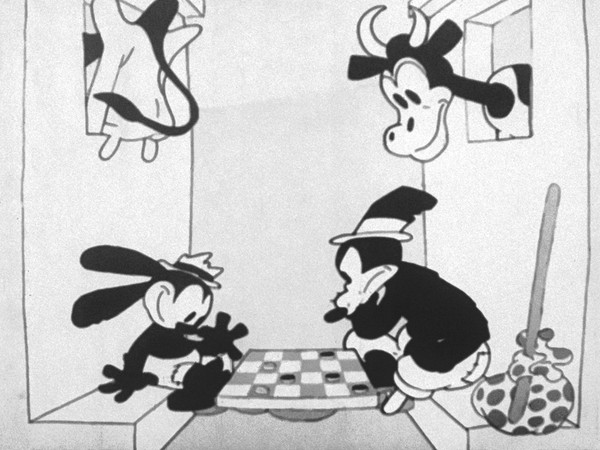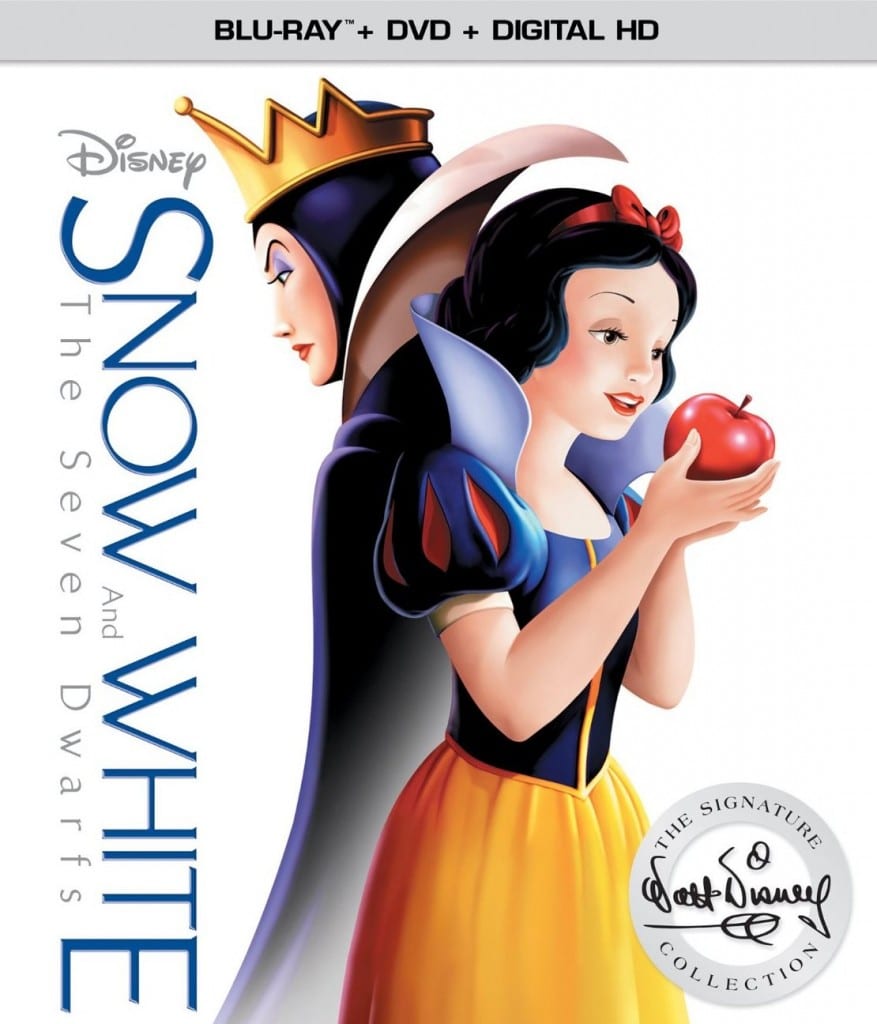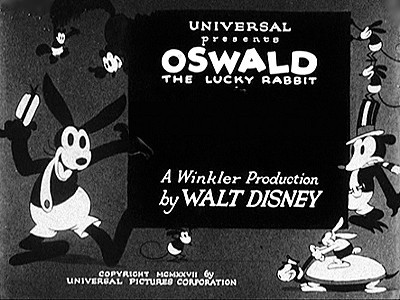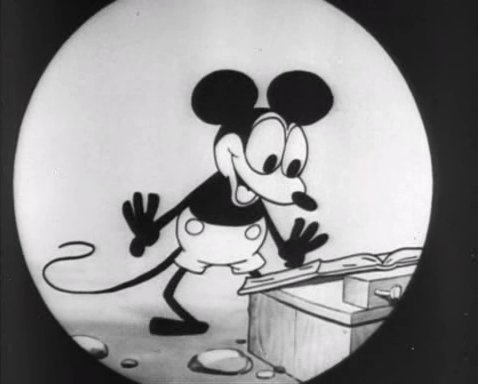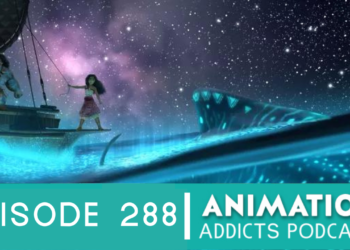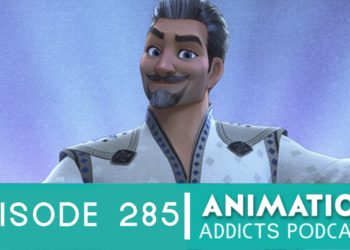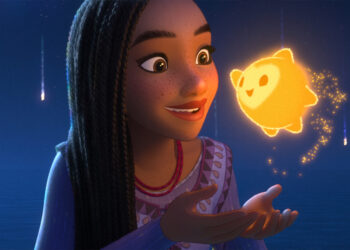What’s old is new again, and if you’re an Oswald fan, you’re in luck. Snow White and the Seven Dwarfs is the premiere volume of the all-new Walt Disney Signature Collection. It hits Blu-ray shelves February 2, and is already available on digital HD. An exclusive digital bonus on the Disney Movies Anywhere app and website is a newly rediscovered 1928 short, “Hungry Hobos“, starring Oswald the Lucky Rabbit. Oswald was Walt Disney’s first animated star, even before Mickey Mouse, and has a unique history all his own.
In a 1928 contractual mishap, Walt realized he had no true ownership of the Oswald character as Universal uprooted most of his animators and continued to make Oswald shorts without Walt. Though the series was long ended, Universal retained ownership of Oswald until 2006, when the Disney Company traded NFL commentator Al Michaels to the Universal-owned NBC in exchange for the rights to Oswald. (Yes, really.) The past decade has seen Disney experimenting with small, different ways to welcome Oswald back to the family, including tracking down many of the shorts from Oswald’s Disney era that have been lost for years. Hungry Hobos is one such short that was only just unearthed in 2011 and is now receiving its first-ever home video release. It involves Oswald and his pal Putrid Pete hitching a ride on a train, which inevitably leads to some unlucky trouble on their part.
To celebrate the release of Hungry Hobos and get to know Oswald a little better, I chatted with animation historian David Gerstein. Extremely thorough in his knowledge of Oswald and Disney past, you’ll find his discussion illuminating and eye-opening. Enjoy.
Rotoscopers: Hi, David. Thank you so much for talking with us today.
David Gerstein: Glad to speak with you, sir.
RS: Well, we are Rotoscopers, an animation podcast and website. I know a lot of our readers are really excited about this newly rediscovered short Hungry Hobos, and we’re just excited to talk to you today about all things Oswald. So, Oswald is a special character in the Disney library, with the story of Walt losing him, then the company welcoming him back ten years ago. As an animation historian, what’s the most intriguing aspect for you of this whole Oswald saga?
DG: Oswald, for me, represents an amazing high point in early animation history. People like to talk about how Oswald led to Mickey Mouse; but there’s also something really to be said for the sheer quality of the crew that Walt and Ub Iwerks put together for Oswald. The Oswald team—which at different times included Hugh Harman, Rudy Ising, Friz Freleng, Ben Clopton, Carman Maxwell, and quite a lot of others—was the common ancestor of both Walt’s 1930s studio and some of its competitors; in 1927 all of these exciting and mercurial personalities were in one place and teaming up, trying to go places.
That spirit of discovery and enthusiasm that marked Disney in the ’30s and led to so many great milestones was there in the ’20s, too. Even with the character of Oswald, there’s this certain walk that he does… waving his arms in the air as if he’s just frustratedly waiting for something to happen. You get the feeling that the whole team had that feeling. They wanted their future now, and you can tell.
RS: Right. You touched on this a little bit, how you said this was a completely different era from Mickey Mouse, and a lot of people compare Oswald to Mickey. A lot of people are still kind of unfamiliar with who Oswald even is. For those of our readers who may have never seen an Oswald short before, how would you describe Oswald’s personality and how would you say that differs from Mickey?
DG: Oswald’s kind of a wise guy with this enormous ego. He likes to think that he’s clever, and lucky, and charming. He really is, but he’s also often the victim of his own overconfidence. He’s a little too impulsive. He loves the idea of adventure and wants to be a hero, and is the first on the block to puff out his chest—but he’s also first to get cold feet.
Mickey creates humor by bravely struggling through danger and encountering comic embarrassment along the way. I mean, think about a heroic person in real life; now put him running up a downward escalator struggling to reach a bad guy while a box of tomatoes dumps on him from above. Basically, Mickey isn’t thinking so much thinking about being a hero as much as he is intuitively just being one, beset by all the comedy we can throw at him.
Oswald, on the other hand, actually thinks about being a hero. He’s a little bit overconfident, he’s a little bit egotistical, he gets in over his head, and he’d rather weasel his way out of a tough situation—his luck provides narrow escapes. It’s almost like Mickey is a hero and Oswald is a wiseguy, wannabe hero, or an antihero.
RS: That’s a very interesting comparison, the way you put it, in terms of both of them wanting to be heroes. I’ve never heard it talked about in that way.
DG: Apart from being a film historian with Disney, I’m also a comics writer and editor for some of the Disney licensees, so I’ve often thought of the differences between one type of personality and the other.
You might say that Mickey’s personality is a bit less inherently funny, but you still have just as much fun with him by putting him in incredible jams. Oswald… let’s put it like this: imagine Mickey if he were a little more egotistical or fallable, or imagine Bugs Bunny if he talked the talk but wasn’t as good at walking the walk.
RS: That’s really cool. So, you were also part of the team that helped discover a lot of these Oswald shorts a few years ago for the Walt Disney Treasures collection. Now we have this new short—well, not new, newly discovered—Hungry Hobos. How does that kind of search even begin? Where do you start, and what can you tell us about the discovery of this particular short?
DG: I wasn’t involved in the discovery of Hungry Hobos, but in looking for the other Oswald cartoons, one of the best ways to locate them was to research what the films were called in other countries. Archives around the world are often sitting on silent films that they cannot identify under their original English language titles. Quite often, they only know the film by what it was called in their country in 1928. A good example is one of the Oswald cartoons that we located for the Treasures set in 2007: Tall Timber, the story of Oswald’s crazy trip down the rapids. Disney sent out a call around the world to see if any archives had a film called Tall Timber. Everybody said no. Then a colleague in Norway sent me a list of some of the original Norwegian release titles. We learned that Tall Timber was called “Storskogen” over there, or “the big woods.” We got in touch with the Norwegian National Film Archives, and they didn’t think they had Tall Timber, but they had “Storskogen.” And that’s the way that one of the films was located.
RS: Hmm. That’s really cool.
DG: If you learn about the films’ release history around the world, it makes it easier to find more of them.
RS: Out of those 26 produced shorts, how many of them are still lost somewhere out there?
DG: Still lost somewhere out there? I haven’t got a count on that, but I’m going to say maybe eight of them.
RS: Wow.
DG: While there were 26 formal Disney Oswald cartoons, the 27th—the first cartoon of the second season—still had Walt’s name on it, so you might imagine that the storyline began with Walt and Ub and their unit. So you could say there are 26 Disney Oswald cartoons and an honorary 27th.
RS: All right, this is my last question for you. This rediscovered short Hungry Hobos is attached to the new Signature Collection for Snow White, which comes at a time when obviously the Disney Studio was in a completely different place, nine years later. What do you think Walt gleaned from his work on the Oswald shorts that he might have infused into creating later projects like Snow White?
DG: I think that the Walt Disney Studio made enormous advancements in personality animation over the course of the Oswald series, and you can see it if you look at the Walt Disney Treasures Oswald DVD set. The very first Oswald cartoons produced have a lot of beautiful, wild motion to them, but when the characters stop to think, they do so with a jerky, staccato kind of movement. If you look later in the Oswald series, you’ll see that when a character stops to think, it’s no longer such jerky poses. The characters’ motions are very smooth; you’ll see that the Disney Studio is trying hard to master personality animation—realistic personality animation.
The cartoon character to beat in 1927 and 1928 was Felix the Cat. Very interestingly, he would never let you forget that he was a drawing. When Felix paces back and forth and tries to solve a problem, his motions are always staccato and jerky. That’s just fine for Felix because Felix is an abstraction of an abstraction, and his personality doesn’t depend on realism. What you can see in the development of the Oswald series is that the Disney Studio is trying to come up a more realistic frame of motion for the characters: a more genuine and human means of personality and communication. While the abstract Felix type of action and the realistic type each have their wonderful, strong points, the kind of push for realism—even in an abstract, crazy landscape like Oswald’s—really made for something new.
Look at the opening of the Oswald cartoon Bright Lights, which you’ll find on the Treasures collection. The first thing you see is a bunch of chorus girls doing the Can-Can on a theater stage while an orchestra below them in the pit plays like crazy. There’s a monkey conductor bobbing up and down as he desperately tries to conduct this orchestra. There are scenes where the team has animated five or six dancers on stage—and the orchestra! It’s their intention to go for broke in movement and excitement. But there’s not a lot of personality. It’s more about creating an atmosphere.
The next thing you see after that is Oswald outside the theater, wishing he could go inside and watch the show, and here’s some remarkable personality animation. Oswald is clearly smitten with Madame Zulu, the cat girl who’s the lead dancer up on stage. Oswald would really like to be inside the theater watching. Very smoothly, he mopes around and looks up at the big picture of Madame Zulu on the theater sign. You get a kind of realistic, smooth emotion and emoting in the character that was very new.
The Oswald solo scene is all the more striking in that it stands out from the scene right before. That scene was pulsing with motion and excitement: doing everything that animation before them had done, but amped up to a new level. Then it’s contrasted immediately with this sensitive, thoughtful scene of Oswald emoting and thinking that goes on for at least a minute straight. It’s fascinating to watch the experimentation and see how the Oswald team is trying so hard to be cutting-edge.
Sometimes you try so hard, you fail, but I think with Oswald, they succeeded. You can see the exact same feeling of juxtaposing different moods and different scenes and different styles of animation… you can still see that exact same flavor in Snow White and any of the cutting-edge productions Disney was working on ten years later.
RS: That’s great. Well, thank you so much for talking with us, David.
DG: Glad to be with you, and glad to be part of the research and discovery process on these great, classic cartoons and on a great character like Oswald.
You can catch Oswald’s heroics in the rediscovered short Hungry Hobos, now available exclusively with the digital purchase of Snow White and the Seven Dwarfs on Disney Movies Anywhere. The set releases to Blu-ray on February 2, and will include a code for digital DMA access.
Edited by: Morgan Stradling


